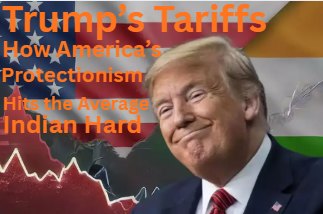– Arshad Shaikh
What is the common man thinking about in the scorching heat in Dharavi (Mumbai), or Chandni Chowk (Delhi)? His eyes are on ration, education-fees, and pending EMIs. But August 2025 has brought Washington into his life. Trump imposed 50% tariff on Indian goods, threatening jobs and inflation. An important foundation of India’s economic journey has been its trade with the US. In 2024, this relationship reached a new height, total trade of $90 billion. India sold goods worth $78 billion.
The US had become India’s largest export market. Textiles, pharmaceuticals, diamonds and jewellery, and auto parts shone. Millions of people work here. But with new tariff rates, the sectors in which India is strong were hit. These tariffs affect exports worth $48.2 billion. The manufacturing sector has been badly hurt. The effect most likely to spread to agriculture and services, shaking India’s rural and informal economy.
Industry and Agriculture in Peril
One of the biggest drivers of India’s exports is the textile and garment industry. These factories are machines of employment. Crores of people work in this sector. Some sweat on thread, some stitch shirts, some load goods. But this backbone of our exports appears to be bending. In Tiruppur, Tamil Nadu, factories are quiet. Orders are drying up. American buyers are turning to Vietnam and Bangladesh. India’s artisans are marginalised. Many are scared of losing jobs.
Experts say tariffs will reduce the contribution of the textile industry. Small dyeing units, trucks, and gig workers are at risk. Unemployment is likely to worsen. Surat in Gujarat is known as the diamond city. Most of the raw diamonds from around the world come here. They are made to sparkle and shine, and then are sold in world markets. It is the identity of Surat, and the basis of livelihood for lakhs of artisans. But now that lustre is fading. America has imposed a tariff of 50% on diamonds and jewellery. Buyers are backing out.
There is fear of reduction in wages of artisans and factories closing down. Artisans of Surat, many from the Muslim community, are wondering what will happen. The marine exports of Andhra Pradesh have also been shaken. Shrimp and fish traders talk of losses. Farmers invested on ponds and fodder are now reducing production. Indian agriculture deploys more than 14 crore farmers, on whom the economy of the villages depends. But now the shadow of tariffs has fallen on them too.
Our exports have been directly affected. Basmati rice, spices, and seafood go to the US. Now the doors are shrinking. The spice growers of Kerala, the cotton farmers of Maharashtra are saying their demand has fallen. The milk producers of Punjab, the fishermen of the east coast were struggling with the climate crisis. Restrictions on processed dairy and seafood are reducing exports, and debt is increasing.
Economic Ripple Effects: Inflation and Job Losses
The Reserve Bank of India projects a 0.8% GDP hit by 2026, if tariffs persist. Inflation is predicted to rise by 1-2% as exporters pass on costs. For the common man, this means costlier essentials. The rupee’s strain, with a widening current account deficit, makes oil and food imports costlier. Wholesale cotton yarn prices jumped 15% in September 2025, hiking garment costs in local markets. Bloomberg warns of 2-3 million job losses in the informal sector, hitting women and minorities. This includes gig workers in Bengaluru and Hyderabad, where app-based delivery and ride-sharing see reduced orders amid factory slowdowns. IT gig freelancers, numbering over 5 million, fear visa curbs and potential service tariffs that could slash U.S. contracts, per Times of India insights. Without social security nets, these precarious workers earning $200-300 monthly face income volatility. When exporters pass on costs, essential items become more expensive. The same clothes, the same pulses, the same oil become more expensive. The same clothes, the same pulses, the same oil become more expensive. This is the story of the common man who is asking – “will our fate be decided in Washington”?
Government’s Response: A Band-Aid on a Gaping Wound
Finance Minister Nirmala Sitharaman announced a slew of reductions on various goods and services. Her words – “This is our shield to protect us from external shocks”. But will problems of crores of people be solved by reducing GST? Will this increase demand, factories start running, and livelihoods be secure? Critics say, ‘No, this is not enough.’ India imposed a 100 % tariff on almonds and apples from America. When trade walls rise, who will be crushed? The common man struggling with inflation. Big announcements matter only when people say, ‘Yes, now my condition has improved.’
A Values-Based Economic Appeal
Jamaat-e-Islami Hind, India’s premier socio-religious organisation has issued a detailed blueprint on how to tackle this tariff-crisis. Some of which are as follows:
Diplomatic Engagement: India must intensify negotiations with the US to secure relief. Punitive tariffs are affecting a large share of Indian exports. Despite multiple rounds of talks, the next meeting has been postponed. The Government of India must prioritise an early resolution that protects MSMEs and workers, without compromising sovereignty.
Emergency Relief Package: A targeted fiscal response is urgently required, including interest subvention, GST refunds, and liquidity easing. The Cabinet is considering a relief package under the Export Promotion Mission. This must include collateral-free loans, enhanced credit guarantees, and direct support for workers in textiles, gems, and leather – sectors facing competitive disadvantages against other countries.
Job Protection Measures: The government must ensure no MSME is forced to shut down. Wage subsidies and employment-linked incentives should be rolled out immediately. Without intervention, India risks losing its labour-intensive manufacturing base and pushing workers into unemployment and poverty.
Export Diversification: India must reduce dependence on the US market by accelerating outreach to Asia, Africa, Europe, and Latin America.
Labor Welfare: A safety net must be established for displaced workers through retraining, social security, and healthcare.
Economic justice is not only a national obligation; it’s a moral imperative. As followers of Islam, we believe wealth must never circulate only among the rich, and that the dignity of labour must be safeguarded at all costs. Exploitation, concentration of wealth, and denial of fair wages are strongly condemned in the Qur’an and Sunnah. The Constitution of India, too, upholds these very values. In this time of global economic turbulence, we remind policymakers that true resilience lies in building an economy anchored in justice, compassion, and fairness. Protecting the poor, supporting small businesses, and defending workers is not an act of charity; it’s their right, and our collective duty.




